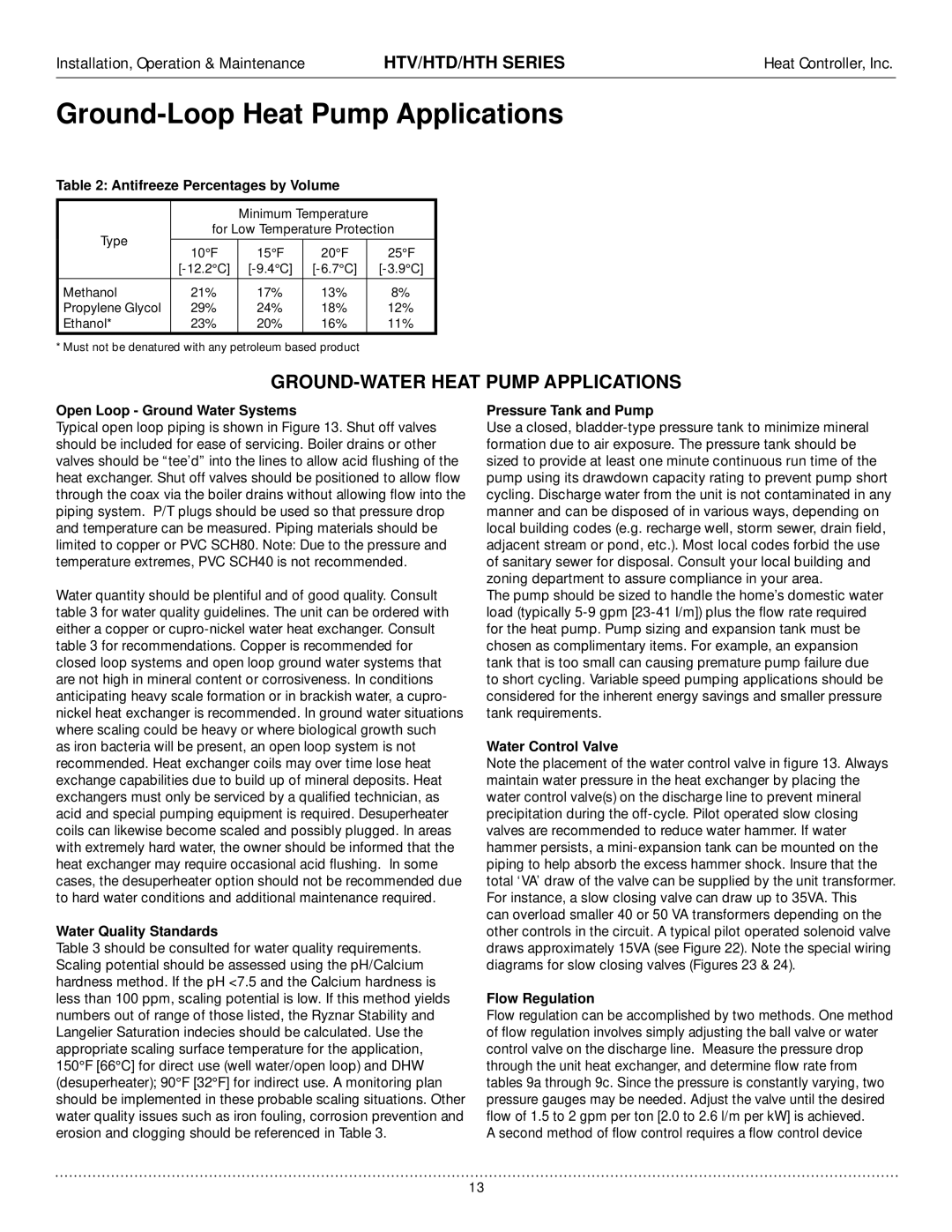Installation, Operation & Maintenance | HTV/HTD/HTH SERIES | Heat Controller, Inc. |
Ground-Loop Heat Pump Applications
Table 2: Antifreeze Percentages by Volume
|
| Minimum Temperature |
| ||
Type | for Low Temperature Protection | ||||
|
|
|
|
| |
10°F | 15°F | 20°F |
| 25°F | |
|
| ||||
|
| ||||
|
|
|
|
|
|
Methanol | 21% | 17% | 13% |
| 8% |
Propylene Glycol | 29% | 24% | 18% |
| 12% |
Ethanol* | 23% | 20% | 16% |
| 11% |
|
|
|
|
|
|
* Must not be denatured with any petroleum based product
GROUND-WATER HEAT PUMP APPLICATIONS
Open Loop - Ground Water Systems
Typical open loop piping is shown in Figure 13. Shut off valves should be included for ease of servicing. Boiler drains or other valves should be “tee’d” into the lines to allow acid flushing of the heat exchanger. Shut off valves should be positioned to allow flow through the coax via the boiler drains without allowing flow into the piping system. P/T plugs should be used so that pressure drop and temperature can be measured. Piping materials should be limited to copper or PVC SCH80. Note: Due to the pressure and temperature extremes, PVC SCH40 is not recommended.
Water quantity should be plentiful and of good quality. Consult table 3 for water quality guidelines. The unit can be ordered with either a copper or
as iron bacteria will be present, an open loop system is not recommended. Heat exchanger coils may over time lose heat exchange capabilities due to build up of mineral deposits. Heat exchangers must only be serviced by a qualified technician, as acid and special pumping equipment is required. Desuperheater coils can likewise become scaled and possibly plugged. In areas with extremely hard water, the owner should be informed that the heat exchanger may require occasional acid flushing. In some cases, the desuperheater option should not be recommended due to hard water conditions and additional maintenance required.
Water Quality Standards
Table 3 should be consulted for water quality requirements. Scaling potential should be assessed using the pH/Calcium hardness method. If the pH <7.5 and the Calcium hardness is less than 100 ppm, scaling potential is low. If this method yields numbers out of range of those listed, the Ryznar Stability and Langelier Saturation indecies should be calculated. Use the appropriate scaling surface temperature for the application, 150°F [66°C] for direct use (well water/open loop) and DHW (desuperheater); 90°F [32°F] for indirect use. A monitoring plan should be implemented in these probable scaling situations. Other water quality issues such as iron fouling, corrosion prevention and erosion and clogging should be referenced in Table 3.
Pressure Tank and Pump
Use a closed,
The pump should be sized to handle the home’s domestic water load (typically
Water Control Valve
Note the placement of the water control valve in figure 13. Always maintain water pressure in the heat exchanger by placing the water control valve(s) on the discharge line to prevent mineral precipitation during the
can overload smaller 40 or 50 VA transformers depending on the other controls in the circuit. A typical pilot operated solenoid valve draws approximately 15VA (see Figure 22). Note the special wiring diagrams for slow closing valves (Figures 23 & 24).
Flow Regulation
Flow regulation can be accomplished by two methods. One method of flow regulation involves simply adjusting the ball valve or water control valve on the discharge line. Measure the pressure drop through the unit heat exchanger, and determine flow rate from tables 9a through 9c. Since the pressure is constantly varying, two pressure gauges may be needed. Adjust the valve until the desired flow of 1.5 to 2 gpm per ton [2.0 to 2.6 l/m per kW] is achieved.
A second method of flow control requires a flow control device
13
